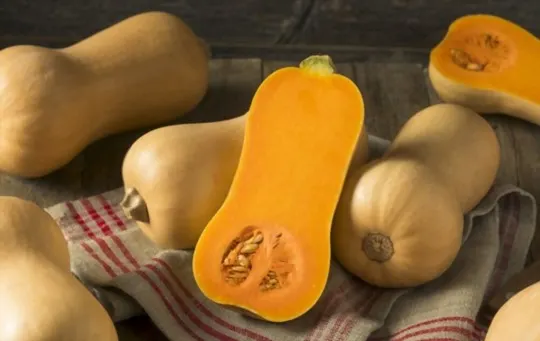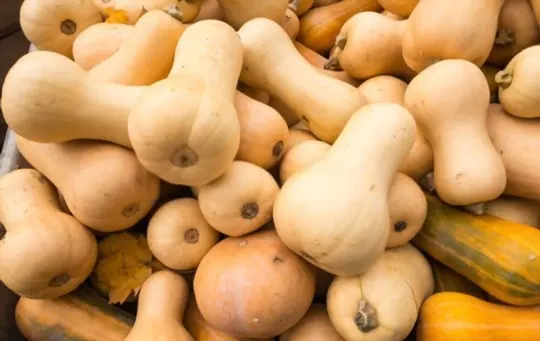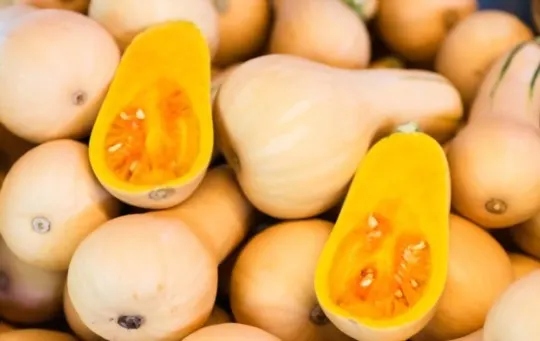Have you ever wondered what squash tastes like?
Whether you’re just curious or trying to decide if it’s something you should add to your diet, you’ll find all the information you need here.
Get ready for a tasty exploration into this popular vegetable.
What is Squash?

Squash is a healthy and popular vegetable that comes in a variety of colors, shapes and sizes.
It grows on vines in gardens or farms and is one of the oldest domesticated plants around.
Squash is highly versatile, as it can be prepared in many different ways – grilled, baked, boiled or raw.
It’s also an excellent source of dietary fiber and provides important vitamins such as vitamin A, B-6 and C.
All these nutrients make it beneficial for promoting eye health, reducing inflammation, increasing metabolic rate and aiding digestion.
In addition to its incredible health benefits, squash can also be used creatively in recipes like soups, salads or steamed vegetables for extra flavor.
What Does Squash Taste Like?

Squash has a mild, nutty, and sweet flavor that varies depending on the type of squash you are eating.
Here are some popular squash varieties and their flavor profiles:
- Butternut Squash: This type of squash is sweet and nutty, with a creamy texture that is perfect for soups and stews.
- Acorn Squash: Acorn squash has a tender, slightly sweet flesh with a nutty flavor. This squash is perfect for roasting and stuffing.
- Zucchini: Zucchini has a mild, slightly sweet flavor with a tender and crisp texture. This squash is versatile and can be grilled, roasted, sautéed, or eaten raw in salads.
- Spaghetti Squash: Spaghetti squash has a mild, nutty flavor and a stringy texture that makes it an excellent substitute for pasta.
- Kabocha Squash: Kabocha squash has a sweet, nutty flavor with a creamy texture similar to pumpkin. This squash is great for roasting and making soups.
Squash is a nutrient-rich vegetable packed with vitamins A and C, fiber, and antioxidants.
Whether you prefer sweet or nutty, mild or bold flavors, squash is a versatile ingredient that can complement any dish.
To enhance the taste of your squash, try roasting it with olive oil, garlic, and your favorite herbs and spices.
Different Varieties of Squash and their Taste

Squash comes in many varieties, and each has a unique taste that can range from sweet to nutty and even slightly bitter.
Below are some of the most popular varieties of squash and their taste profiles:
1 – Summer Squash
Summer squash is a tender and mild-tasting squash that is perfect for adding to salads, grilling, and roasting.
It has a delicate and slightly sweet flavor, with a soft and creamy texture when cooked.
The skin of the summer squash is also edible and adds a slight bitterness to the flavor profile.
When preparing and cooking summer squash, it’s essential to not overcook it, or it can turn mushy and lose its flavor.
Instead, aim for a firm texture that is lightly browned when grilled or roasted.
Other varieties of squash, such as acorn squash, butternut squash, and spaghetti squash, have different flavor profiles and textures.
Acorn squash is nutty and sweet, while butternut squash is similar to pumpkin in flavor and texture.
Spaghetti squash has a mild, nutty flavor and is well known for its stringy texture when cooked, resembling spaghetti noodles.
Squash is low in calories, high in fiber, and a good source of vitamins A and C.
Adding squash to your diet can help boost your immune system and promote healthy digestion.
So, next time you’re at the farmers’ market or grocery store, consider adding some squash to your list and try out its unique flavor.
2 – Winter Squash
Winter squash, which is harvested in the fall, has a sweet and nutty flavor that is perfect for a wide range of dishes.
Depending on the variety, the taste of squash can range from mild and slightly sweet to rich and nutty, with notes of brown sugar and hazelnut.
Here are some common varieties of winter squash and their flavor profiles:
- Butternut squash: This variety has a sweet and nutty flavor, with notes of brown sugar and a smooth texture.
- Acorn squash: Acorn squash has a mild and slightly sweet flavor, with a tender texture.
- Spaghetti squash: This variety has a mild and slightly sweet flavor that is perfect for savory dishes. When cooked, the flesh becomes stringy and can be used as a healthy alternative to pasta.
- Kabocha squash: Kabocha is a Japanese variety of winter squash that has a dense and sweet flavor, with notes of chestnut and a tender texture.
- Delicata squash: Delicata squash has a sweet flavor with creamy pulp and hints of corn and sweet potato.
- Squash can be roasted, pureed, mashed, boiled, grilled, or sautéed, making it a versatile and nutritious ingredient in a variety of recipes.
Try roasting squash with olive oil and spices like cinnamon and nutmeg to bring out its natural sweetness.
Factors that Affect the Taste of Squash

Squash has a unique and versatile flavor that can be influenced by many factors.
The taste of squash can range from sweet and nutty to earthy and savory, depending on the variety, ripeness, and cooking method.
Here are some factors that can affect the taste of squash:
- Variety: Different varieties of squash have distinct flavor profiles. For example, acorn squash has a nutty and sweet taste, while butternut squash is creamy and earthy.
- Ripeness: The taste of squash can change depending on its ripeness. As squash matures, it becomes sweeter and more flavorful. However, if it is overripe, the flavor can become too strong and bitter.
- Season: Squash that is in season usually tastes better than out-of-season squash because it is fresher and hasn’t been transported over long distances.
- Cooking method: The taste of squash can also be influenced by the cooking method. Roasting, grilling, and sautéing can enhance the natural sweetness and nuttiness of squash, while boiling or steaming can make it more watery and bland.
- Soil and climate: The area where squash is grown can affect its taste as well. Squash grown in well-drained and nutrient-rich soil tends to be sweeter and more flavorful.
By considering these factors, you can choose the best squash variety and cooking method to suit your taste preferences and make the most of this versatile and delicious vegetable.
1 – Ripeness
Squash comes in many different varieties, each with its unique flavors and textures.
The taste of squash depends on various factors like the type, size, color, and ripeness level of the squash.
For example, summer squash like zucchini tastes mild and slightly sweet, while winter squash like pumpkin can be nutty, sweet, and savory.
The ripeness of the squash also impacts its taste.
Ripe squash will have a sweeter taste than unripe squash, which can be more bitter.
Here are some common squash varieties and their taste profiles:
- Butternut squash: sweet and nutty.
- Acorn squash: sweet and slightly nutty.
- Spaghetti squash: mild and nutty.
- Delicata squash: sweet and creamy.
- Hubbard squash: sweet and rich.
When cooking squash, it’s best to experiment with different cooking methods like roasting, baking, sautéing, and grilling to bring out the best flavors.
Pro tip: When in doubt, try a small piece of raw squash to get a sense of its taste profile before cooking it.
2 – Cooking Method
When it comes to cooking squash, the method can greatly affect the taste and texture of this versatile vegetable.
Here are some of the most common cooking methods for squash and how they can impact the flavor:
- Roasting: Roasting squash can bring out its natural sweetness and give it a caramelized flavor. This method also results in a tender texture and crispy edges.
- Steaming: Steaming squash can help preserve its natural flavors and nutrients. However, this method can sometimes leave the vegetable with a slightly bland taste.
- Boiling: Boiling squash can soften its texture, making it ideal for soups and stews. However, this method can also lead to a loss of flavor and nutrients.
- Grilling: Grilling squash can add a smoky flavor and a slightly charred texture, which can be delicious when paired with other grilled vegetables or meats.
- Sautéing: Sautéing squash can help the vegetable caramelize and develop a rich, deep flavor. However, be careful not to overcook the squash, as it can become mushy and lose its texture.
To enhance the flavor of your squash dishes, try adding herbs, spices, or sauces.
Popular choices include garlic, rosemary, thyme, balsamic vinegar, or honey.
3 – Seasonings and Spices
Squash is an incredibly versatile vegetable, and its mild yet nutty flavor pairs well with various seasonings and spices, depending on the squash variety and the desired final dish’s flavor profile.
Here are some seasoning and spice options to consider when cooking with squash:
- Cumin: Cumin’s warm and earthy flavor complements the nuttiness of squash well. Sprinkle some ground cumin on roasted butternut squash, for example.
- Sage: Sage has a slightly minty, savory flavor that pairs well with the sweetness of winter squashes, such as acorn, delicata, or pumpkin.
- Thyme: Thyme’s subtle herbal notes enhance the flavor of summer squashes, such as zucchini or pattypan. Add some fresh thyme to sautéed or grilled squashes.
- Cinnamon: Cinnamon’s sweetness and warmth make it a popular spice for many squash recipes, especially those involving baked or pureed squashes.
If you’re unsure about what spices and seasonings to use with your squash, start with simple combinations such as salt and black pepper or olive oil and garlic, and then experiment with other flavors gradually until you find the perfect combination.
Health Benefits of Squash

Squash is a versatile vegetable that tastes mildly sweet and nutty, with a tender and slightly crisp texture.
But squash isn’t just delicious; it’s also packed with health benefits.
Here are some of the top health benefits of squash that you shouldn’t overlook:
- Squash is low in calories and high in fiber, making it an excellent food for weight loss and digestion.
- Squash is rich in antioxidants such as vitamin C and beta-carotene, which can help to protect against cancer and other chronic diseases.
- Squash is a good source of potassium, which can help to lower blood pressure and reduce the risk of heart disease.
- Squash is also rich in other essential nutrients such as vitamin A, magnesium, and folate, which can support many aspects of your health, from skin and hair health to immune function and healthy pregnancy.
So if you’re looking for a tasty and healthful vegetable to add to your diet, consider incorporating more squash into your meals.
You can roast it, sauté it, steam it, or even use it to make squash noodles or a creamy squash soup.
How to Prepare Squash for Cooking?
Before cooking squash, it’s essential to prepare it correctly.
Here’s a step-by-step guide to preparing squash for cooking:
- Wash the squash thoroughly under running water to remove any dirt or debris.
- Cut off the top and bottom of the squash with a sharp knife.
- Use a vegetable peeler to remove the skin from the squash. For tougher varieties like butternut squash, you can also use a knife to cut off the skin.
- Cut the squash in half lengthwise and use a spoon to scoop out the seeds and pulp. Discard the seeds and pulp.
- Slice or dice the squash according to your recipe’s instructions.
Squash is a versatile vegetable that can be prepared in many ways, from roasting to sautéing to grilling.
Its taste can vary, depending on the variety of squash.
For example:
- Butternut squash has a sweet, nutty flavor with a creamy texture.
- Acorn squash has a slightly sweet and nutty flavor with a fibrous texture.
- Spaghetti squash has a mild, nutty flavor with a stringy texture that resembles spaghetti.
- Overall, squash has a mild, earthy flavor that pairs well with many herbs and spices.
It’s also an excellent source of nutrients, including vitamins A and C, fiber, and potassium.
Fact: Squash is believed to have originated in Mexico over 10,000 years ago and was used as a food source by Native Americans for centuries.
So, don’t be afraid to experiment with different types of squash in your cooking – you might just discover a new favorite.
Conclusion
In conclusion, squash has a mild, nutty flavor that can be sweet or savory depending on the variety and how it’s prepared.
From acorn squash to zucchini, there’s a squash out there to suit every palate and recipe.
Whether roasted, steamed, grilled, or mashed, squash is a versatile and healthy ingredient that can add flavor, color, and nutrients to your meals.
When selecting squash, look for firm, unblemished skins and store them in a cool, dry place for up to a few weeks.
Don’t be afraid to experiment with different squash varieties and cooking methods to find your favorite way to enjoy this tasty vegetable.
So, next time you’re in the store or at the farmers’ market, pick up a squash and try it out for yourself.

What Does Squash Taste Like? A Comprehensive Guide
Ingredients
- Squash
- Ingredients from your selected recipes
Instructions
- Select your favorite ingredient from the range available in this article.
- Collect all the necessary items to make the recipe.
- Use the instructions provided to prepare a delicious dish in 30 minutes or less.

Carrie is a food writer and editor with more than 15 years of experience. She has worked for some of the biggest names in the food industry, including Bon Appétit, Food & Wine, and Martha Stewart Living.
As the Editor in Chief of IntroChicago.com, Carrie oversees all of the content on the site. She also manages the team of contributing writers and editors, who help to create delicious recipes, helpful tips, and informative articles that you’ll find on the site.
A native of the Chicago area, Carrie is passionate about all things food. She loves trying new restaurants and experimenting with new recipes in her kitchen. She’s also a graduate of the Culinary Institute of America, so she knows a thing or two about food!
